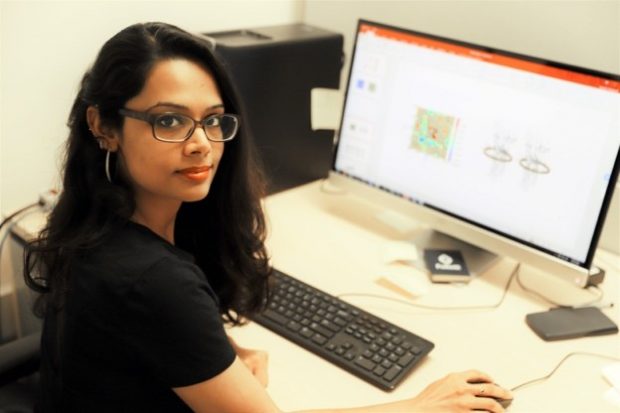
Groundbreaking research takes time.
Research computing resources at Syracuse University help speed up the clock.
Nandhini Rajagopal is a biomedical and chemical engineering doctoral student in Professor Shikha Nangia’s lab in the College of Engineering and Computer Science. Last month, Rajagopal won the American Chemical Society’s Chemical Computing Group Research Excellence Award, which recognizes outstanding computational chemistry research conducted by graduate students.
For her research, Rajagopal takes advantage of the University’s Academic Virtual Hosting Environment and the Crush virtualized research cloud. Crush provides access to dedicated, customized compute nodes for high-performance and high-throughput computing. It is used in tandem with the AVHE, which houses the data and work scheduling infrastructure.
We recently spoke with Rajagopal about how these resources advance and accelerate her research.
Q: How do you explain your research to people? What problem are you trying to solve?
A: My research at Professor Shikha Nangia’s lab is about understanding the blood-brain barrier, which has been one of the greatest challenges in achieving drug delivery to the brain to treat neurodegenerative diseases like Alzheimer’s, Parkinson’s, brain tumors and many others.
I have been trying to understand how a particular family of proteins called claudins interact to impart the barrier properties that safeguard the brain from foreign entities but block the passage of essential therapeutic drug molecules.
Q: How did you connect with ITS’s Research Computing team?
A: I was introduced to ITS’s Research Computing team through Professor Nangia’s lab. I am a fifth-year PhD student, and I have been using Research Computing facilities for my research throughout my graduate tenure.
Q: What specific resources do you use? What do these resources allow you to do that otherwise might not have been possible (or at least would have been harder to do)?
A: For my research project work, I have extensively used the University’s AVHE cluster.
In my thesis project, we investigate molecular interactions between proteins using computational methods that require several months of dedicated computer recourses or high-speed computing facilities (which would still take weeks).
In 2019, I developed a new algorithm called “Protein Association Energy Landscape” (PANEL) to simulate protein-protein interaction. Unlike the previous method, the PANEL method divided the large and complex simulation into multiple smaller, more affordable simulations, each requiring only a few hours of computer time. These systems were designed such that they could run in parallel, which required multiple nodes. Typically, one protein system consisted of approximately 3,000 smaller sub-systems.
AVHE facilitated hundreds of nodes to run parallel jobs. As a benchmark, a system that would take about 81 days to complete by the earlier method is now completed in about 3.5 days using PANEL (with 100 AVHE nodes and 4,000 high-throughput cores).
The AVHE cluster facilitated the implementation, testing and time efficiency of the PANEL method. Also, we received prompt help from the Research Computing team each time we ran into an issue.
In this project, the Academic Virtual Hosting Environment is coupled to Crush. The head scheduling node and data servers reside in the AVHE, but the compute nodes come from Crush.
– Research Computing Group
Q: Have you been leveraging research computing resources since the University shifted to remote learning? If so, how?
A: The work at the Nangia lab is purely computational, and a significant amount of our work is performed using Syracuse University research computing resources on a regular basis. Since the University started operating remotely, our lab has been working remotely using research computing facilities by activating Syracuse University Remote Access.
Q: When you’re not in the lab, how do you like to spend your free time?
A: During my free time, I like to do some creative art, puzzle-solving or learning activities. I’m a trained vocalist in Indian classical music, so sometimes I practice music. I love listening to world music, usually traditional folk while I cook or paint. Other times I like to solve puzzles or explore and learn new things; recently, I learned to use Morse code. I also like to watch comedy shows.
